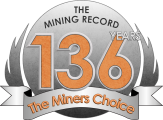Historic Drilling AT The Copper Mountain Project
Historic Drilling AT The Copper Mountain Project
VANCOUVER – Myriad Uranium Corp. reported a compilation of significant historic eU3O8 grade intervals at its Copper Mountain project, compiled from cross-sections prepared by Anaconda Uranium in 1997. These cross-sections were found during the Company’s ongoing review of proprietary paper-based historical data sets. The intervals confirm that there is high grade material close to the surface at Copper Mountain and give Myriad a clear path to re-evaluating the resources and confirming the feasibility of mining, taking the Company much closer to production than previously thought.
The intervals relate to 82 boreholes drilled into what Anaconda called the “High Grade Zone” of the North Canning deposit by a subsidiary of Union Pacific Railway, Rocky Mountain Energy (RME). RME had intended North Canning to be the centre of a three-pit mine they were planning in the late 1970s. The cross-sections include a significant number of high-grade intervals (up to 0.385% eU3O8) and many long, mineralized intervals (up to 291 feet). Grage-Thickness (GT) products range from the minimum selected 0.3 ft% (equivalent to 0.1% over 3 feet) to 11.55 ft% (represented by 0.05% eU3O8 over 231 feet).
CEO Thomas Lamb, said, “These are exciting cross-sections. They demonstrate that there is significant high-grade uranium at Copper Mountain and they provide us with a roadmap to fast-track the required confirmation work. These particular boreholes were drilled in the High Grade Zone at an important structural boundary of the North Canning area, adjacent to the more moderate-grade zones of the main North Canning deposit area. Union Pacific had intended the North Canning deposit to be a moderate-grade bulk-tonnage central pit for a large mining operation. They had conducted considerable test work and built a heap leach pad before discontinuing development due to fast-falling uranium prices at the end of the 1970s.
Historically, other high-grade zones away from North Canning saw only limited drilling and we are now armed with geological insight to help us pursue trends – particularly faults that are now much better understood and have not been explored yet. This gives us confidence that we can increase overall grades and volumes relative to RME’s historic estimates and also consider alternatives such as initially developing a current resource estimate for just the smaller high-grade areas of North Canning as a first step.”




Comments (0)